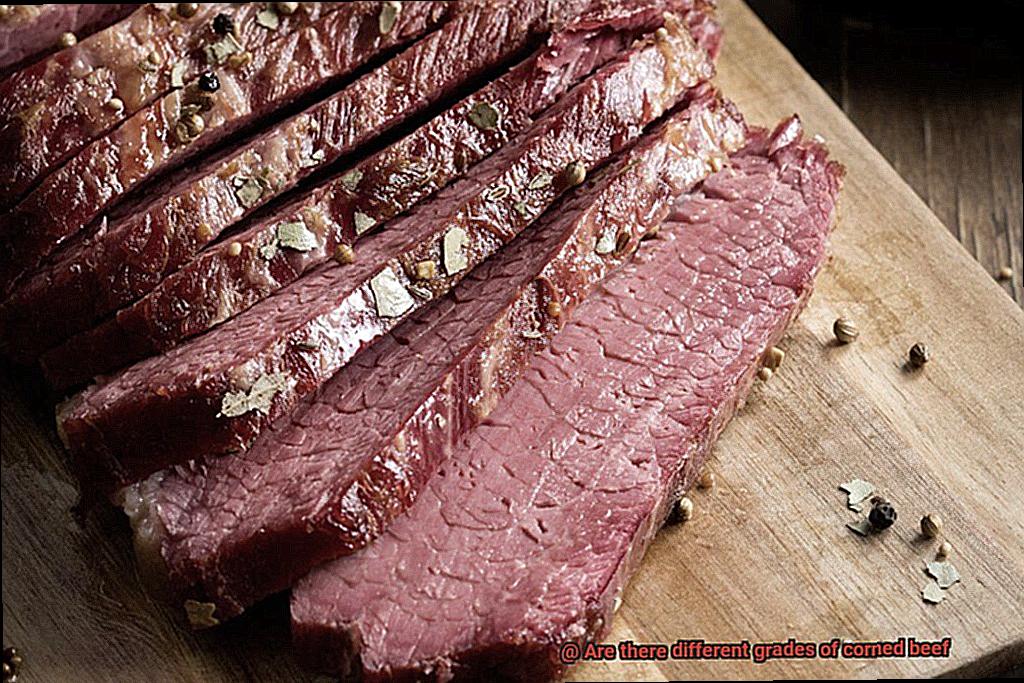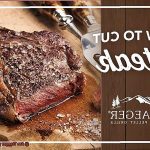Corned beef is the ultimate comfort food that has been a staple in many households for generations. Whether you’re celebrating St. Patrick’s Day or craving a hearty meal, corned beef is always a reliable choice. But did you know that not all corned beef is created equal?
Contrary to popular belief, corned beef comes in different grades, each with its unique texture, flavor, and preparation method. From the cut of meat to the breed of the cow it comes from, every detail matters in creating the perfect corned beef.
Join us on an exciting journey into the world of corned beef as we explore its fascinating history and evolution from a traditional Irish dish to a beloved American classic. We’ll delve into the various grades available in today’s market and help you choose the best one for your recipes.
Whether you’re an avid corned beef enthusiast or just starting to discover this delicious dish, this blog post will provide you with all the information you need to know about different grades of corned beef. So get ready to indulge in mouth-watering flavors and learn how to make your own perfect corned beef at home.
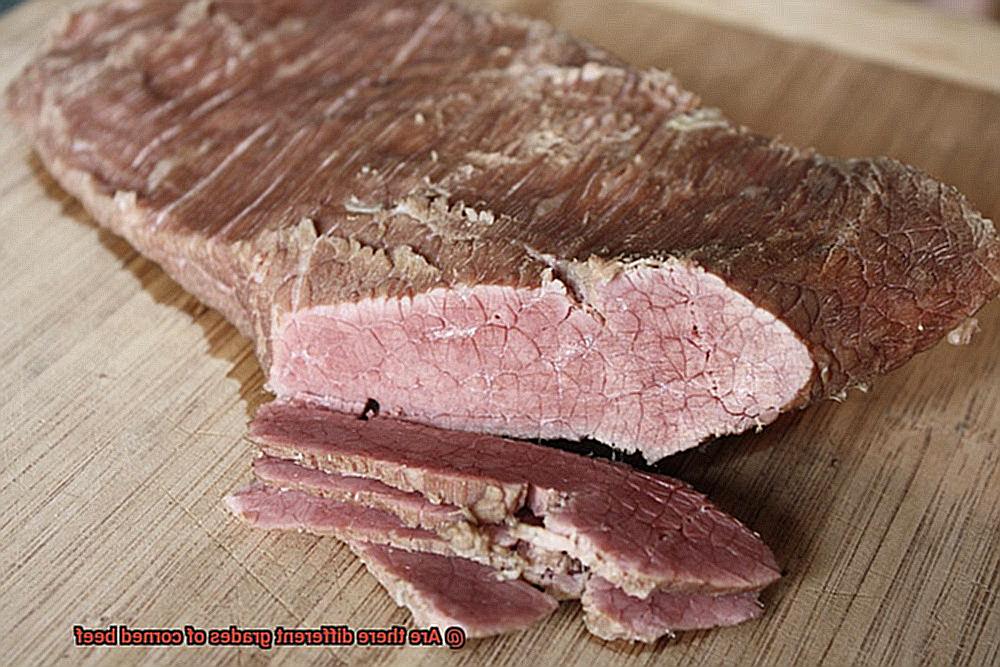
Contents
What is Corned Beef?
Corned beef is a beloved meat product that has been enjoyed by people around the world for centuries. It is made from beef brisket, which is a cut of meat from the lower chest area of the cow. The term “corned” refers to the large grains of salt that are used to cure the meat, giving it its distinctive flavor and texture.
Corned beef has a rich history dating back to the 17th century when it was first produced in Ireland. Since then, it has become a popular staple in many households around the world, especially in North America.
There are two main types of corned beef available: canned and fresh. Canned corned beef is pre-cooked and has a longer shelf life, making it a convenient option for storage and quick meals. Fresh corned beef, on the other hand, is prepared and cooked from scratch and is often considered to be of higher quality due to its fresh taste and texture.
In addition to the two main types, corned beef can also be classified by its grading. The United States Department of Agriculture (USDA) assigns three grades of corned beef based on factors such as marbling, age, and color: Select, Choice, and Prime.
- Select grade corned beef is the lowest quality and has less marbling than Choice or Prime. It is also typically less expensive.
- Choice grade corned beef has more marbling than Select and is considered to be of higher quality.
- Prime grade corned beef is the highest quality and has the most marbling, resulting in tender and flavorful meat.
When selecting corned beef, it’s important to consider both the type and grade to ensure that you get the best quality and flavor possible. Fresh corned beef of any grade will provide a deliciously rich taste that makes it perfect for a variety of meals such as sandwiches or stews. Canned corned beef can be a great option for those who need a quick and easy meal.
Different Grades of Corned Beef
Corned beef is a beloved staple of many households, especially during St. Patrick’s Day. It’s a tasty meat product made by soaking the beef in brine, which is a solution of salt and water, for several days before cooking. But did you know that there are different grades of corned beef available in the market?
First things first, let’s talk about the grading system. Unlike other types of beef, corned beef is not graded by prime, choice, or select. Instead, the grading system is based on the cut of meat used to make the corned beef. The most common cut of beef used for corned beef is brisket – a tough cut of meat that comes from the breast area of the cow.
When it comes to corned beef, there are two grades: flat cut and point cut. Flat cut corned beef comes from the leaner section of the brisket, while point cut corned beef comes from the fattier section. Flat cut corned beef is more expensive than point cut because it is leaner and has less fat. It is also easier to slice because it has a more uniform shape. On the other hand, point cut corned beef is cheaper than flat cut because it contains more fat and is not as uniform in shape. However, some people prefer point cut because they believe it has more flavor due to the marbling of fat throughout the meat.
Now, let’s explore different brands of corned beef available on the market. Some popular brands include Boar’s Head, Hormel, and Omaha Steaks. Each brand may have its own unique recipe and seasoning blend. For instance, Boar’s Head corned beef is known for its tenderness and juiciness, while Hormel offers an affordable option for those on a tight budget.
Prime Grade Corned Beef
Look no further than prime grade corned beef – the pinnacle of all corned beef varieties.
What sets prime grade corned beef apart from the rest is its incredible marbling. This high-fat content enhances the meat’s flavor and tenderness, resulting in a succulent and juicy meat that will leave you wanting more. The smooth and tender texture of prime grade corned beef is also a standout quality that makes it a favorite among food enthusiasts and chefs alike.
But not all corned beef is created equal, and it’s important to look for specific labeling when shopping. Prime grade corned beef must adhere to rigorous USDA standards to be labeled as such. Be sure to look for the “prime” or “USDA Prime” label on the packaging to ensure that you’re getting the best.
When it comes to cooking, prime grade corned beef is incredibly versatile. Whether you’re grilling, braising, or roasting this premium meat, it will surely be a crowd-pleaser. And with its high marbling content and tender texture, it’s no wonder that prime grade corned beef is such a luxurious and delicious choice for any meal.
To sum up, here are the key points to remember about prime grade corned beef:
- Made from the most tender and flavorful cuts of beef
- Cured with a special blend of spices and seasonings
- High marbling content for enhanced flavor and tenderness
- Smooth and tender texture that melts in your mouth
- Look for specific labeling (“prime” or “USDA Prime”) when shopping
- Versatile cooking options for any meal
Choice Grade Corned Beef
If so, you may have heard of choice grade corned beef. But what makes this grade of meat so special? Let’s dive in and explore the world of choice grade corned beef.
Firstly, it’s important to note that the United States Department of Agriculture (USDA) sets the standards for grading meat, including corned beef. Choice grade corned beef is rated as the second-highest grade of meat, with only prime grade being higher. When shopping for corned beef, keep an eye out for the USDA stamp indicating its grade on the packaging.
So, what sets choice grade corned beef apart from other grades? One key factor is marbling. Marbling refers to the amount and distribution of fat within the meat. Choice grade corned beef has a moderate amount of marbling, contributing to its tenderness and rich flavor. Additionally, it has a bright red color and minimal external fat, making it a healthier option.
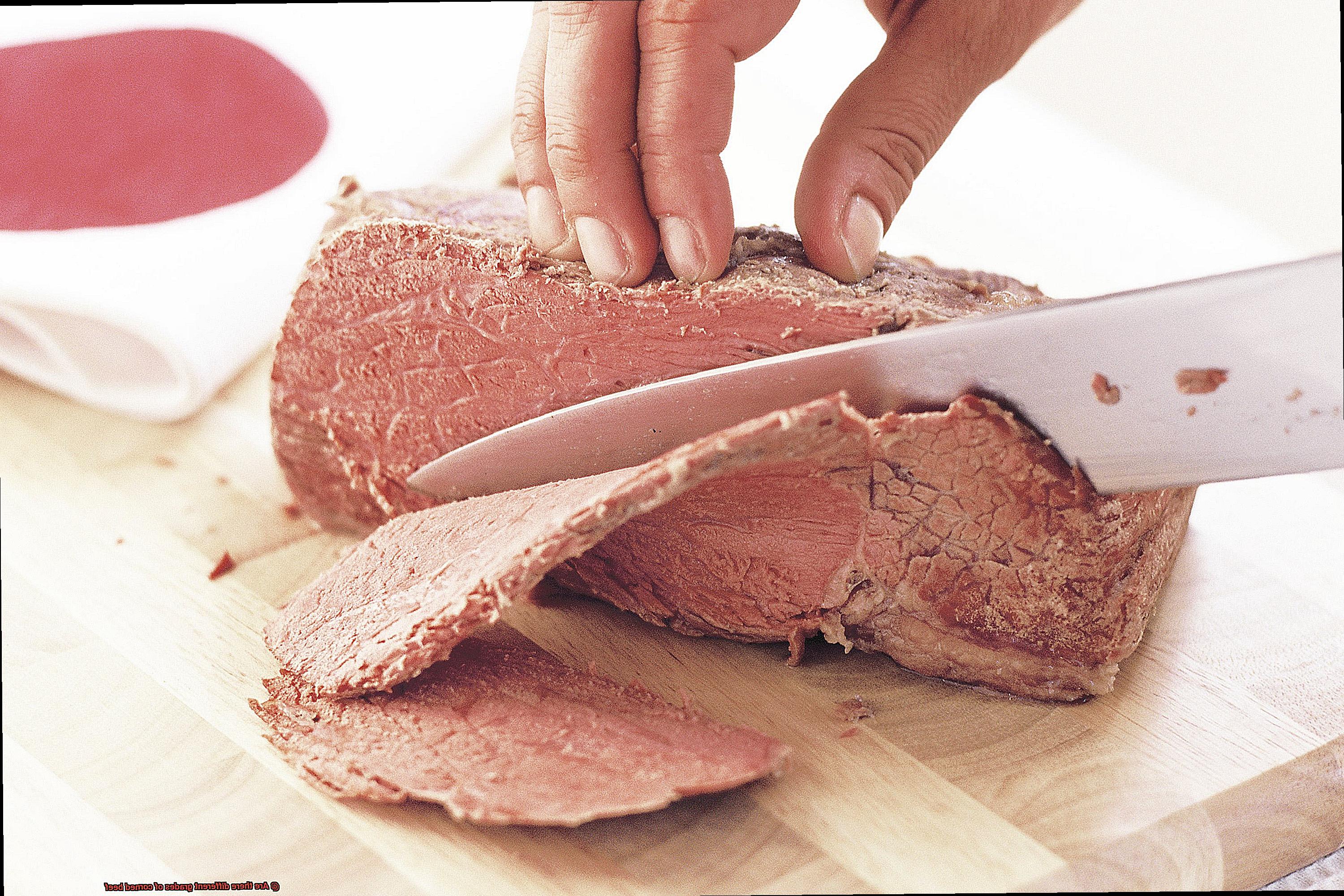
But how can you ensure that you’re getting the most out of your choice grade corned beef? Proper cooking techniques are essential. Start by selecting high-quality meat and brining it correctly. Then, cook it low and slow until it’s juicy and tender, an experience that will leave your taste buds jumping with joy.
Commercial Grade Corned Beef
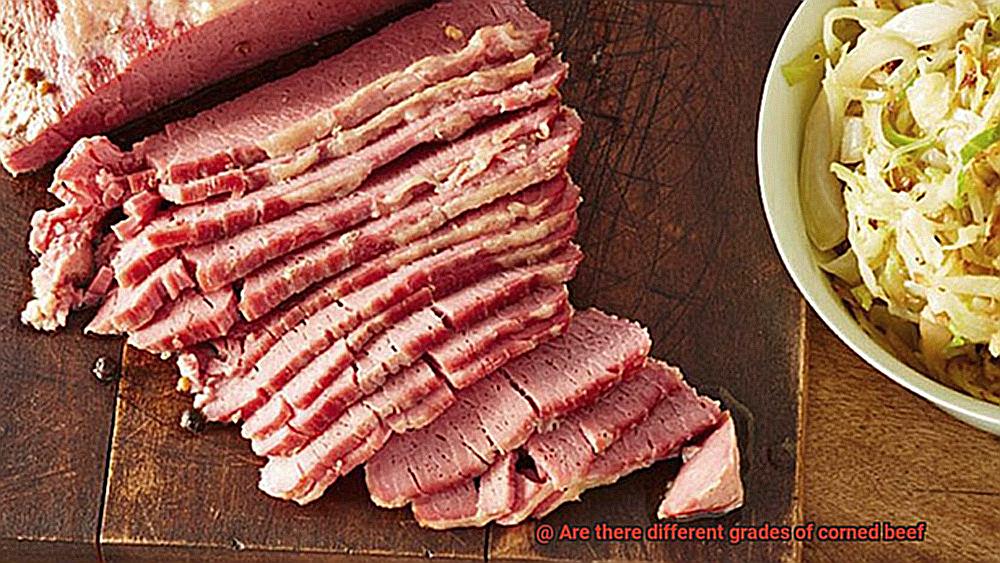
Then you must have come across commercial grade corned beef at your local grocery store. This classic dish made from a lower quality cut of beef such as brisket or round, that has been brined with salt, sugar, and spices. But what makes commercial grade corned beef different from the rest? Let’s find out.
Firstly, the cut of meat used in making corned beef plays a vital role in its quality. Although brisket is the most commonly used cut, some manufacturers may use other cuts like round or chuck. Therefore, it is essential to check the label and do some research on the quality of the cut of meat used.

Secondly, the brine used to cure the meat is a significant factor that affects both flavor and overall quality. Some brands may use low-quality ingredients or skimp on the spices, leading to a bland and less flavorful product. Additionally, some brands may use artificial preservatives or additives in their brine, which can affect the taste and overall quality of corned beef.
Despite these potential variations in quality, commercial grade corned beef can still be an excellent option for those looking for a convenient and affordable way to enjoy this classic dish. Whether you’re making a traditional corned beef and cabbage dinner or using it as a sandwich filling, there are plenty of ways to enjoy this tasty meat.
Benefits of Different Grades of Corned Beef
Corned beef is a beloved meat that has been enjoyed by people all over the world for centuries. But did you know that there are different grades of corned beef available in the market? As an expert on this topic, let me tell you about the benefits of choosing a higher grade of corned beef.
First and foremost, opting for a higher grade of corned beef means better quality meat. The grading system takes into account marbling, color, and texture, and the higher the grade, the better the quality. This translates into a more tender and flavorful meat with fat marbling throughout that keeps it moist during cooking. Who doesn’t love a juicy and succulent bite of corned beef?
But it’s not just about taste – a higher grade of corned beef also likely comes from better quality cattle. These animals are often raised in better conditions and fed a healthier diet, resulting in more nutritious meat for you to consume. So not only will you enjoy the taste of your dish, but you’ll also be nourishing your body with high-quality protein.
In addition, higher grade corned beef will have a deeper red color and a more uniform texture, which can enhance the visual appeal of your dish. Who says food can’t be both delicious and beautiful? So whether you’re cooking for yourself or entertaining guests, choosing a higher grade of corned beef can elevate your culinary experience.
Of course, it’s important to note that higher grade corned beef may come with a higher price tag. But fear not – there are still plenty of options available for lower grade corned beef that can be just as delicious and satisfying. It all comes down to personal preference and budget.
How to Choose the Right Grade of Corned Beef for Your Meal
St. Patrick’s Day is just around the corner, and if you’re planning a traditional feast, corned beef is a must-have dish. But with so many different grades of corned beef available, it can be challenging to know which one to choose. In this post, we’ll break down the different grades and give you tips on how to choose the perfect one for your meal.
Understanding the Different Grades
The first step in choosing the right corned beef is understanding the different grades available. Select, Choice, and Prime are the most common grades. Select is typically the least expensive option and has less marbling and a lower fat content, making it slightly tougher than the other grades. Choice offers a good balance between flavor and tenderness, while Prime is known for its exceptional marbling, tenderness, and flavor.
Consider Your Cooking Method
When deciding which grade of corned beef to choose, consider how you plan to cook it. For slow cooking, a lower grade like Select may work well since it will have more time to break down and become tender. However, if you’re going to grill or sear it, a higher grade like Choice or Prime may be a better option since it will be more forgiving and won’t dry out as easily.
Think About Your Budget
Prime grade corned beef may be the best option in terms of flavor and tenderness, but it can also be quite expensive. If you’re on a tighter budget, Select or Choice may be a more affordable option that still offers good flavor and texture.
Check the Cut
The cut of the corned beef can also affect its flavor and tenderness. Plate or first cut corned beef is leaner and has less fat than other cuts, making it more expensive due to its high quality. Point or second cut comes from the front part of the brisket and has more fat, making it juicier and more flavorful. Flat or third cut comes from the bottom part of the brisket and has the most fat content, making it very tender and juicy but also greasy.
Consider Your Preferences
Ultimately, the right grade of corned beef for your meal will depend on your personal preferences. If you prefer leaner meat, a higher grade like Prime may not be as enjoyable for you. Consider your taste buds and what you enjoy eating when making your choice.
Choose Quality Ingredients
No matter which grade of corned beef you choose, make sure to use quality ingredients when making your dish. Fresh vegetables, herbs, and spices can enhance the flavor of your corned beef and make your St. Patrick’s Day meal one to remember.
Tips for Cooking with Different Grades of Corned Beef
Corned beef is a beloved dish that comes in different grades, each with its own unique qualities. Whether you’re a seasoned chef or a home cook, understanding the different grades and how to cook them can help you achieve the best possible outcome. Here are five tips for cooking with different grades of corned beef.
Know Your Grades
The quality of corned beef varies depending on the grade of meat used and the curing process. The most common grades are prime, choice, and commercial. Prime corned beef is made from high-quality meat and traditional curing methods, resulting in superior tenderness and flavor. Choice corned beef has more marbling than commercial, making it a popular choice for those who want to balance taste with health benefits.
Adjust Cooking Times and Techniques
Different grades of corned beef may require different cooking times and techniques. Lower grade corned beef may require longer cooking times or additional seasoning to enhance its flavor and tenderness. A higher-grade cut like prime may only require minimal seasoning and tenderizing due to its superior marbling.
Choose the Right Cut
There are three common cuts of corned beef: brisket, round, and flank. Each cut has its unique characteristics that affect cooking times and techniques. Brisket is the fattiest cut, resulting in tender meat full of flavor when slow-cooked using methods such as braising or smoking. Round is leaner than brisket, requiring more extended cooking times but still producing juicy and flavorful meat when cooked correctly. Flank is the leanest cut, ideal for slow-cooking methods like braising or smoking to achieve tenderness and flavor.
Pay Attention to Seasoning
Seasoning corned beef correctly is essential to bringing out its unique flavor profile. Different cuts may require varying levels of seasoning depending on their fat content and flavor profile. It’s crucial to taste and adjust the seasoning as needed to ensure a balanced and flavorful result.
Consider the Cooking Liquid
The cooking liquid used can also impact the final flavor of the dish. For brisket, a rich beef broth or beer-based liquid can add depth and richness, while for round or flank, a lighter broth or water-based liquid may be more appropriate to allow the meat’s natural flavor to shine through.
J_vYhEqDgIM” >
Conclusion
In conclusion, corned beef is a meat that offers a range of grades, each with its unique qualities. From the cut of meat to the curing process, every aspect plays an essential role in creating the perfect corned beef. Whether you’re a seasoned chef or a home cook, understanding the different grades and how to cook them can help you achieve the best possible outcome.
When it comes to selecting corned beef, it’s crucial to consider both the type and grade to ensure that you get the best quality and flavor possible. Fresh corned beef of any grade will provide a deliciously rich taste that makes it perfect for a variety of meals such as sandwiches or stews. On the other hand, canned corned beef can be an excellent option for those who need a quick and easy meal.
It’s important to note that different grades of corned beef may require varying cooking times, techniques, seasoning, and liquid to bring out their unique flavor profile. Therefore, paying attention to these details when cooking with different grades of corned beef is crucial.
No matter which grade of corned beef you choose, using quality ingredients when making your dish is vital. Fresh vegetables, herbs, and spices can enhance the flavor of your corned beef and make your meal one to remember.

